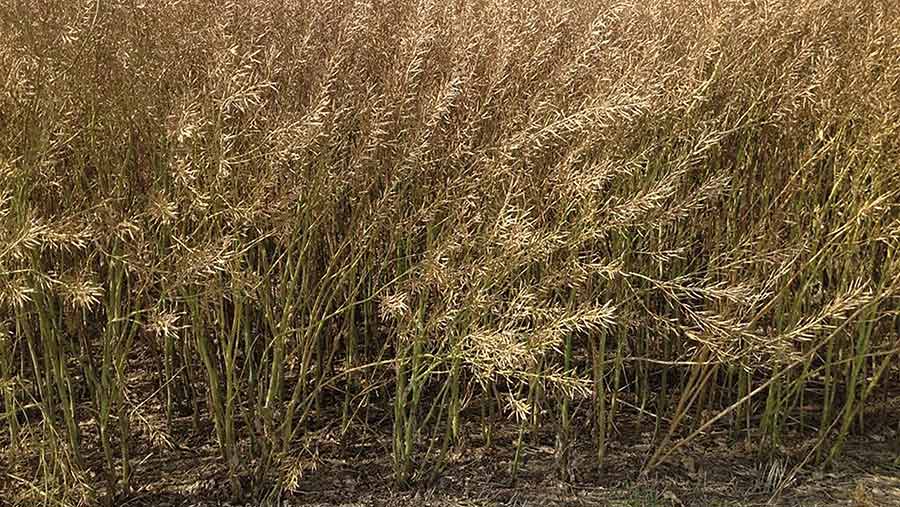New winter varieties help to address mustard shortfall
 © English Mustard Growers
© English Mustard Growers Drought in Canada and war in Ukraine have combined to disrupt mustard supplies, with even the French region of Dijon having well-publicised problems securing supplies of brown mustard seed for its famous condiment in 2022.
Having previously imported 80% of its requirement from North America, France found itself facing a mustard shortage when a severe drought hit the mustard-producing region in Canada in 2021 – which saw production fall from 180,000t/year to just 65,000t.
See also: Ukraine export disruption creates gap in UK millet market
The outbreak of war in Ukraine then added to the problem as the 85,000t produced in the country stopped happening, explains Greg Bliss of English Mustard Growers, who adds that the dedicated grower group was keen to react and try to make up some of the shortfall.
“It’s fair to say that we are selling all the mustard we can grow at the moment,” he admits. “If we can produce more, the opportunity is there.”
As a result, English Mustard Growers has 1,800ha of mustard in the ground with contracted growers this year, split 50/50 between spring- and autumn-sown crops of both brown and white mustard, which go to Colman’s and other customers.
New winter variety
A new overwintered white variety, Guthrie, is being grown for the first time in the UK, following success with an overwintered brown variety, reveals Mr Bliss.
“We’ve been on a steep learning curve on how to grow it in local conditions, having listened to French producers. It’s early days, so we’re still learning and sharing our experiences among the group.”
Having worked closely with Elsoms on breeding and seed supply, the development of Guthrie and its subsequent performance in trials gave them the confidence to earmark 700ha for its production this year.
“The new variety is as frost tolerant as we can get,” he adds. “It’s had quite a test this winter, with some extended cold snaps, which took their toll on all brassica crops, but any damaged patches can always be redrilled in the spring.”
Overwintered mustard varieties have advantages, especially when it comes to avoiding the pest pressures associated with the later-flowering spring types and the risk that a very dry spring season poses to small-seeded crops, explains Farmacy agronomist Rich Daubney.
Later drilling
They are also drilled later than oilseed rape, in October, so largely avoid the flea beetle onslaught, he adds. In spring, flowering takes place at the same time as oilseed rape, which helps to dilute the pollen beetle threat.
As a brassica, mustard is susceptible to other pest issues that affect oilseed rape, such as pigeons, although the compounds contained in the plant that give it the heat do seem to make it less palatable than its close relation.
This year, the core group of 22 English Mustard Growers members has risen to 33, reports Mr Bliss, most of whom have increased the area grown on their farms.
“They are mainly in Cambridgeshire, Lincolnshire, Norfolk and Suffolk, as the soils are suitable and they are within striking distance of our purpose-built facility Condimentum in Norwich.”
Rotational considerations
One of those growers is Michael Sly, chairman of English Mustard Growers, who farms at Thorney, near Peterborough.
While mustard has been grown on the farm for more than 100 years, he has opted for 100ha of the overwintered crop this year. “It has replaced oilseed rape in our rotation,” he explains.
“As with all crops, there can be weather challenges to be overcome, which is why we work together as a group to improve our knowledge and share our experiences.”
Otherwise, much of the additional area has come at the expense of potatoes, he notes, reflecting the rising costs and greater risks associated with the crop and the extreme market volatility. Mustard can be grown on a one-in-five basis if the rotation doesn’t include oilseed rape.
Spring-sown crops will yield about 1.25t/ha, with overwintered white varieties doing slightly more at 1.5t/ha and overwintered brown mustard averaging 1.8-2t/ha.
There is a specification to meet, as the seed size must fit the mill and it goes for human consumption as an uncooked product. The ability to colour sort the seed has made this easier.
“There’s no default market for it,” stresses Mr Bliss. “So it has to be looked after, tested for contaminants and free of black seeds. These parameters are all in the contract that a grower signs.”
High returns
Given the shortage, mustard is currently trading at very high prices, in excess of £1,000/t, he continues.
“It would be wrong to assume that this is going to last forever, but the crop is currently giving a better gross margin than oilseed rape. Brown-mustard growers tell us it gives them the best margin on the farm.”
While there’s always been a good relationship with Colman’s, which is now part of Unilever, there are other buyers of mustard in the UK who are also keen to source locally.
Mustard agronomy
Mustard is a lower input crop choice than oilseed rape and fulfils the same role as a break, providing a good entry for winter wheat, says agronomist Rich Daubney of Farmacy.

© Hutchinsons
As with oilseed rape, the establishment stage is when things can go wrong, although the advent of winter-sown varieties has helped to remove some of that risk, he notes.
While the herbicide options for the mustard crop are limited, with no approval for either Kerb or Astrokerb (propyzamide with/without aminopyralid) in the autumn, Centurion Max (clethodim) has been cleared for use and provides some level of blackgrass control, he says.
Phoma is less of a concern with mustard, but the crop is susceptible to light leaf spot and can suffer from white blister and alternaria later on in the growing season.
Fortunately, there are several fungicides cleared for use, including Amistar (azoxystrobin)-type products and azoles, reveals Mr Daubney.
Nitrogen rates are similar to those used in oilseed rape, he says, with a winter mustard receiving in the region of 160-180kg of N/ha and a spring crop requiring 120-140kg of N/ha.
The winter mustard crop is affected by frost in much the same way that oilseed rape is, although the white varieties seem to fare better than brown. “If there’s been a kind autumn and there’s lots of soft growth, frost damage can look awful. Usually, crops will recover.”
Growers interested in producing mustard should alter their cover crop mixes accordingly and leave it out of those, he advises. “We need to avoid any pest and disease carryover, as well as contamination at harvest.”
Harvesting can be done in several ways, from swathing to desiccating and direct combining, after which the crop needs to be looked after in storage.
“It needs to have air blown through it – you can’t just leave it in a heap. It’s a high-value crop, especially at the moment.”

